First Quarter: Oak, mistletoe
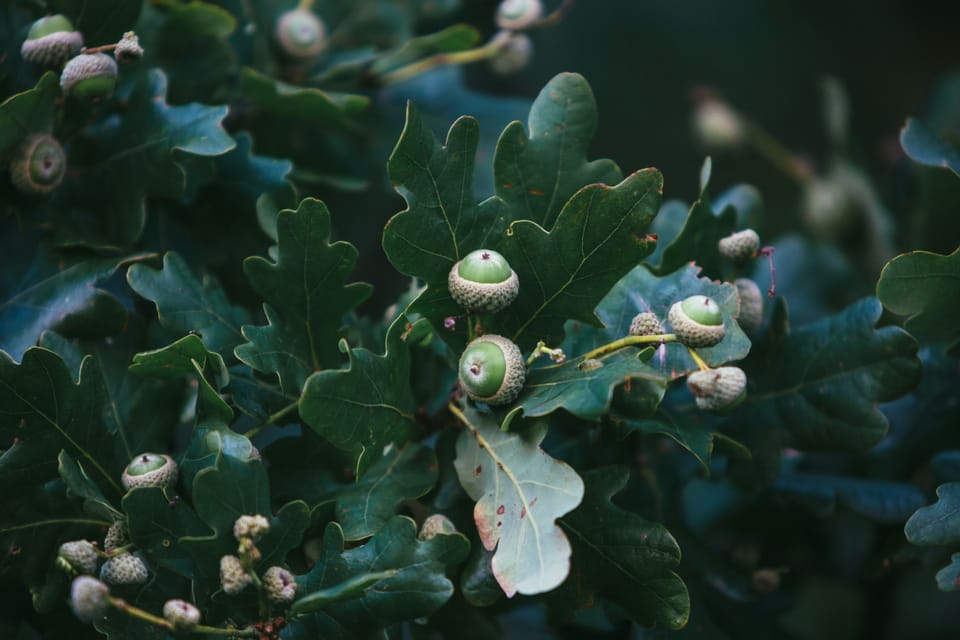
Hello. It's Friday, and we're in what I call the hinge of summer. As mirrored at the opposite side of the year, the Sun is not yet at true solstice — but he has begun to stall. Increases in day length are now tinier and tinier, and this creates a feeling of time slowing down. Nowadays I consider this period subtly sacred, a profound fortnight; even outside the holiday Litha (Midsummer) itself, the Oak King's court is making their final preparations to revere him at the height of his power, and the revels will continue for days before that power truly starts to dwindle.
So hail, hail, hail the Oak King! He and his wintry counterpart the Holly King have come up in this newsletter before. A mythmaking and myth-interpreting device of the writer Robert Graves, they are one way I recognize my two-in-one god, who is a solar (and satanic) deity from other angles but who is also inextricably present in the forests and fields, for all plants and animals depend upon the Sun's light. My god is also the Green Man and the Lord of Beasts. And so all trees are his, and in the dark half of the year his most powerful and iconic tree is the holly, and in the light half of the year the crown is worn by the oak.
I don't have to cleave to Graves' particular arboreal choices for a seasonal narrative of warring kings, yet long ago I found those choices suited my understanding of the cosmos very well. The winter tree is straightforward in that respect: I've written of holly's cultural significance already, and I'll simply highlight that it's an apt cross-continental winter plant for a settler like me to build a relationship with, given how the holly that natively grows where I live is not the holly my ancestors would have revered but it's holly (and beautiful) nonetheless. But what of the oak?
I think there are more misunderstandings to dispel there, and so that is the focus of today's tree lore post — along with a parasitic shrub that is frequently (but somewhat erroneously) associated with oaks in many neopagan settings.
Oak
The loosely recorded spiritual and governing figures of the Iron Age Celts are generally identified as the Druids, from which the modern religious practice of Druidry takes its inspiration. Because of how little was actually written or preserved in known oral tradition about the old Druids, we cannot be certain of matters like...
- Exactly how far across Britain and Ireland the institution of the Druids was spread
- Exactly what function a Druid performed (although they may have been analogous to tribal elders)
- Who could be a Druid (although it's assumed, correctly or not, that only men were)
- Anything in particular that the Druids believed, practiced, or taught to laypersons in their communities
But we do know one thing from pure linguistics, which is that to be a Druid meant something to do with trees, and maybe oak trees in particular. The Proto-Celtic *druwits would be the source of the Gaulish, Latin, and French words that give us "Druid," and druwits most likely derives from earlier Indo-European stems for "tree" and "seeing/knowledge." In some sense a Druid was a tree-seer, a tree-knower, though this suggests an array of possibilities: an ethnobotanical guardian who literally holds special knowledge of trees, or a wise person whose knowledge was either imbued by the trees or understood metaphorically as a tree-like pillar of their community. The root for "tree" here, *dóru, also might just mean "sturdy, solid, firm," but based on the words that ultimately evolved from it in various languages, the sturdiness in question was clearly equivalent to that of a tree, of wood.
The oakiness of this tree-knower can be inferred more specifically from the later Celtic languages who share that Proto-Celtic origin, shifting from *dóru to *daru. In modern Cymric, Cornish, Breton, Irish, Scottish, and Manx respectively, "oak" is now derw, derow, dero, dair, darach, and darragh[1]. The broader category of "tree" has shifted to different words with different roots — suggesting that *daru took on the specificity of "oak" at some point before all these surviving Celtic languages diverged, which also meant the shift in meaning probably took place before the Romans colonized Britain and documented the Druids there.[2]
Of course, we only know from this linguistic investigation that if any one tree was afforded special importance among the Druids and their late Iron Age kindred of pre-Roman Britain, the oak is a highly likely candidate; and this does at least align with Roman records of Druids treating mistletoe gathered from oaks as uniquely holy (more on this in the mistletoe section). But leaving aside whether the Roman records are accurate or not, why was a word originally for "tree" eventually allocated to "oak," and not to some other genus? Why the oak itself?
This is where we can only speculate. In the Old Irish literature that describes the ogham lettering system, the letter d, called dair for oak, is explained as ardam dosae, the "highest tree." Oaks certainly can grow quite large, and they're one of the longer-lived deciduous trees, with massive 500-1000 year old specimens in ideal locations. They produce edible acorns, the tannins in their bark have always been a staple of leather production, and oak is among the strongest and heaviest woods. Fungi that live in relationships with oak include the magnificent edible hen-of-the-woods and chicken-of-the-woods; in general, oaks are keystone species, with entire forest ecosystems depending partially on their presence. While pre-Christian Germanic traditions may have cast an ash or yew as Yggdrasil, the tree at the center of the universe, if such a tree existed in Celtic lore perhaps it was an oak.[3]
It is largely from these reflections that I originally felt moved to follow Graves and center the oak as the tree of summer. The exact meaning of this tree to my ancestors may be lost, but it also seems both self-evident and worth unlocking the mystery for myself in this day and age.
And luckily, like holly there are endless oaks to admire, revere, and learn from where I live. I do live in what Robin Wall Kimmerer calls Maple Nation, so the maples also deserve my special attention (and I've written about them here) but my immediate bioregion still has close to a dozen native oak species that play their own roles in shaping the mixed broadleaf-conifer forests of this land. This time of year they're also just wrapping up spraying their pollen everywhere. And although some oaks become very drab in the autumn, some species like the northern red oak (Quercus rubra) do put on a fiery show that season. I love walking under the low-spreading red and gold canopies of autumnal maples, but I also love walking among red oaks with bright splashes of color up against the blue sky while their enormously thick, twisty trunks surround me at ground level.
I am certain that one of the greatest reasons to revere the oak is its keystone status. So much ecologically comes together at its roots and in its branches. But with that in mind, I will now turn my attention to that teased question of a plant which is said to grow in oak canopies: mistletoe.
Mistletoe
When I first started to learn more about mistletoe, the first thing that surprised me is that this parasitic, poisonous plant does not have anything special to do with oaks. Common mistletoe (Viscum album) grows most often on apple, hawthorn, linden, and poplar. Of course, these trees have their own mythology and folklore across Europe, with apple and hawthorn featuring heavily among the Celts, but this makes it seem strange that the Romans would document the Druids as craving to collect mistletoe from oaks above all other trees. If nothing else, this discrepancy should lay to rest an idea that I glossed over in the above section: how perhaps the oak would be seen as sacred to the ancient Celts because it was a mistletoe host. That now strikes me as very unlikely.
But thus the opposite possibility seems interesting instead. If mistletoe and oaks are not a common combination, maybe their co-occurrence deserves ritual attention. So what makes mistletoe remarkable on its own, and why would combining it with the oak perhaps create a rare but extra potency? I've been thinking about this for a while, and here is what I've usually come up with.
Mistletoe has a few features that suggest magic. It is evergreen, so even when the trees it grows upon have shed their leaves, its green-gold hue still adorns them. All parts of the plant are poisonous, too, and toxicity often inclines a plant to receive some special cultural attention, whether its dangerous compounds are intentionally used for death or carefully managed to produce a medicinal effect. In Nordic lore, mistletoe is the poison on the arrow or spear that kills Baldr, whose murder ultimately incites the Ragnarök. For the Celts, who can say what mistletoe meant (if the Romans even accurately reported their interest in it), but I think a dual function of death and medicine is plausible.
And there is certainly one aspect of mistletoe that colors how someone in an animist mindset might regard this plant as distinctive from others. This is the sticky texture of the white berries. It very clearly resembles semen, so for the Celts as much as for some other cultures (like in ancient Greece) it wouldn't surprise me if mistletoe was treated as a very special symbol of fertility, virile or otherwise.
From there it doesn't take much to imagine that if someone in bygone days found this plant growing on an oak — itself a fertile linchpin of the forest, not to mention phallically rising and possessed of decidedly hard wood — this might seem particularly fortunate, and any mistletoe collected in this context might be perceived as more powerful than usual.
I can't prove any of this, but I also doubt I'm the first ritualist to consider these possibilities. In any case, because it's a connection that my own mind makes in this day and age, it seems reasonable to let such fertility value attach itself to mistletoe and oak together in the future, regardless of what's happened before. Mistletoe does not feature terribly prominently in my rites except as another winter plant, paired with holly sometimes for being another evergreen; but perhaps it ought to be an anchor between the solstices.
I will privately meditate further on this, throughout the hinge of summer.
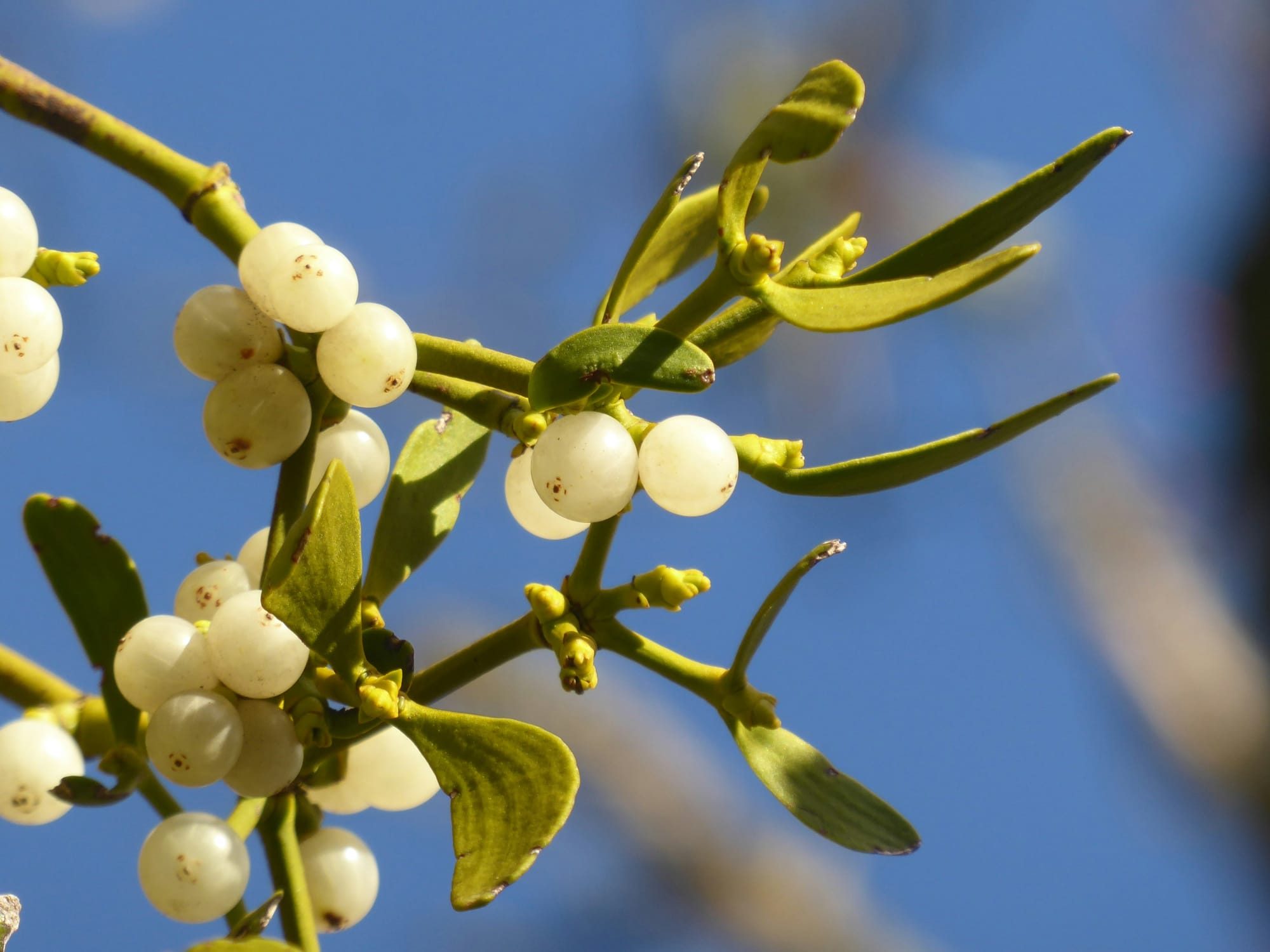
[1] In most if not all of these cases, the nouns given here are plural forms as these are used by default. It's presumed that where there is one oak, other oaks will also be present.
[2] The Brythonic languages, Cymric and Cornish and Breton, were still united as the same language of Common Brittonic during Roman occupation; but Irish, Scottish, and Manx's ancestral Goidelic language had already diverged from the same shared origin as Common Brittonic hundreds of years beforehand, due to the geographic separation of Britain and Ireland. (Note that Scottish Gaelic, though spoken on the isle of Britain, exists purely due to early medieval Irish settlement of the Highlands, where previously the lost Pictish culture and language were present.) Thus it is significant that modern Celtic words derived from *daru all carry the "oak" meaning, because it would most logically have had this meaning as far back as the Brythonic/Goidelic split deep in the Iron Age, when the Druids were ostensibly established or already active.
[3] This could be a rather arbitrary cultural development if so. Oaks grow across the Germanic cultural sphere, have been used for many of the same things as Celts would have, and Old Norse even has an ambiguity between the word eik meaning equally "tree" or "oak." Likewise, the ash and the yew are quite significant in the Celtic sphere. But if oaken supremacy within Celtic cultures is one thing that might have once characterized them distinctly from their Germanic neighbors, it's at least anthropologically interesting regardless of why it came to be.
Though it was on the shorter side, I hope this was an interesting read. This newsletter rapidly evolved from its inception into a passion project where I feel called to spill thoughts that I waited a long time to spill — or that I find inherently healing to write about — but I wouldn't have started here without several people urging me to do something like this, and saying they would even pay me to do so.
A year and a half later, I am still debating the long-term financial and logistical realism of continuing here. It costs me a small amount per month to operate and I do not yet have enough paid subscribers to break even on that amount. It also takes me 4 to 8 hours to write most posts. I don't like asking for money or acting like what's here deserves to be behind a paywall, so I keep these asks infrequent; but if you've been reading for free, please consider paying in order to reduce the chance that I eventually need to end this.
Thank you for reading, and I'll be back next week with a special Litha post focused on a commonplace fertility legend. After that, I'll be writing a key essay on abandonment complexes, the loneliness epidemic, and the help I've found in relation-making.
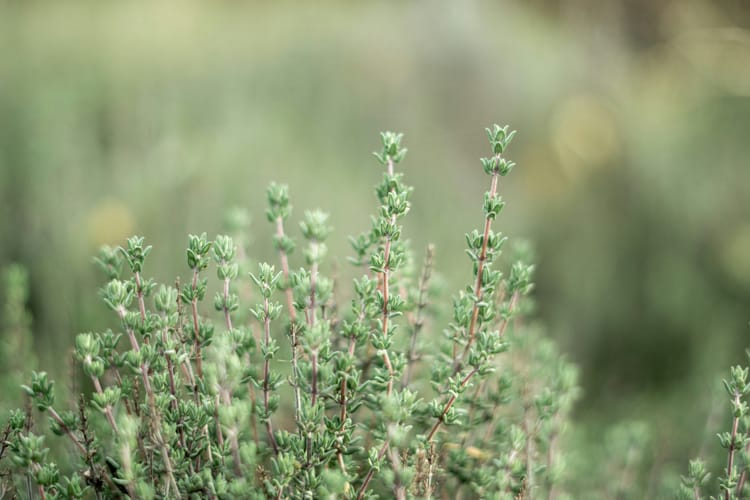
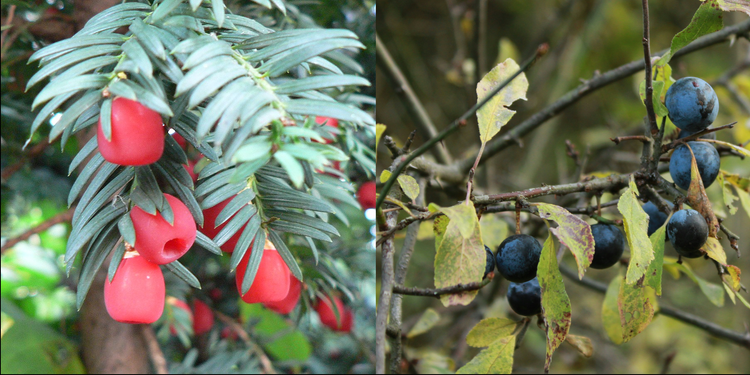

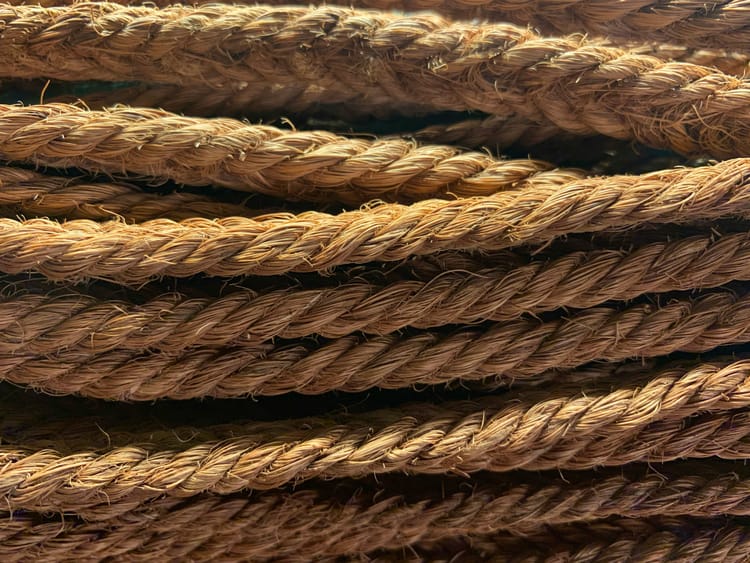
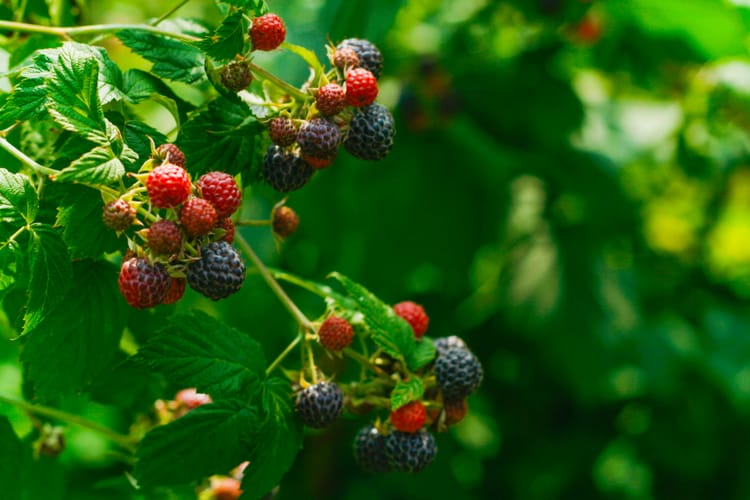
Member discussion